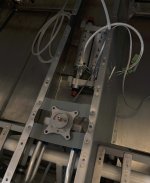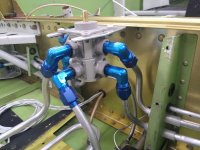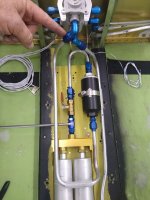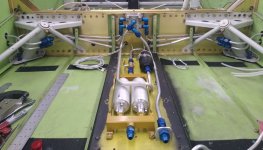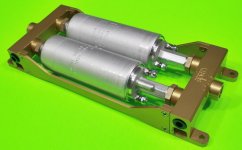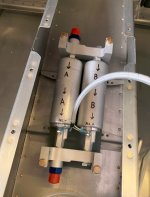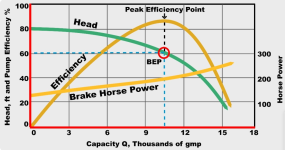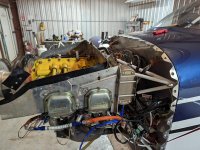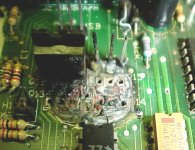I have no idea about the pump (but it’s a common car pump so likely very reliable)Maybe I’m not understanding how electronics fail etc. In my mind though, a small fire in that box could kill the engine and all the aircraft power in one go. Is this a unrealistic fear?
I imagine a pump failure after takeoff wouldn’t be the pump actually failing but could be a blocked filter, pooped cb, chafed wire, bad electrical design etc. Point is there’s a perfectly good pump next to it which if off! Why can’t it be on?
I wondered that too but was afraid to ask! Having said that, the only real difference is the header area on the SDS pimps versus a banjo fitting on the second pump. Perhaps the banjo fitting is the cause of Robert’s concerns on cavitation etc on the suction side? Who knows.
Can the post filter be on the firewall with no issues?
Is this because the leaded fuel kills the oxygen sensor?
When you've produced over 10,000 controllers in almost 30 years, turned them loose on the public and accumulated an estimated 23 million hours collectively on the fleet, you'll eventually see some interesting things.
I put a lot more weight on historical experience- demonstrated MTF rather than something like FMEA which just asks what if? There are so many single points of failure on single engined aircraft that if you did an FMEA on it, you'd have a long list and maybe wouldn't fly at all.
So here is a photo of the worst "fire" we've seen in an ECU (EM-4).
Obviously very high current flowed through this component for a long time to cause this type of damage indicating an unfused component somewhere along the line, most likely the ECU power lead where we recommend 2 amps max. Usually once the trace burns up and things go open, the heating stops. If this ECU was actually fused with 2 amps, this damage could never have happened.
We've seen people inject 400V from an MSD into the wrong place and fry things too but that won't happen on Lycoming setup where there is no MSD.
I've only seen one legit and unexplained failure to date on an aircraft ECU and that was on Greg's 9A. He arrived back safely on the B ECU. This appeared to be a simple component failure on something rated at 200V. Normally these parts are very robust and never fail but with enough hours on almost anything, you are bound to eventually see a failure.
Have seen 2 other separate failures traced to the av tech installer wrapping the IAT and CHT sensor cables around the plug wires for a couple feet. Obviously you'd never want to do this. Inductance and capacitance coupling can do bad things when you have pulsing 30KV an 1/8th of an inch away from sensor input wires. He came back to base on the B ECU as well.
We're approaching a million flight hours on the SDS aviation fleet now, nobody has had a fire on a board, shutting down both yet. The risk would appear from this data to be very small if fused as recommended.
We have seen pumps fail for no apparent reason- even upon disassembly. A good reason to have 2. As I mentioned, we've heard of 6-7 failing to date and several more being damaged by partially plugged filters and having to be replaced.
I'm not sure that anyone has established that the Brand X pump modules have any issue. Why doesn't someone just test it and report back here? Don't theorize, simply run the experiment and see if the concern is valid. Speculation without facts is useless.
Yes, we usually recommend mounting the post filter FWF. Easy to access there and won't drip inside the airplane when you check/ service it.
Correct, as Greg said above, closed loop hasn't been implemented on 100LL burning aviation engines because sensor life is nowhere near what it is in the automotive world- say around 5000 hours. We have seen failures in as little as 2 hours though the high time user has almost 650 hours on his sensor. Quite a range.
I see a trend here in this thread where people surmise a problem with no apparent data to make the concern a valid one. I suggest folks evaluate what is being said and WHY. Is the advice based on hearsay or factual history of a problem? Is it just marketing or idle conjecture?
One of the main reasons I post here is to answer questions about our products as we have hundreds of customers here on VAF. I hope my answers hold up to technical and factual scrutiny. We try to turn out the most durable and reliable bits that we can. I personally fly what we sell. We replace parts that show issues in the field and we issue SBs to alert users of things to check and look out for. User feedback is most important to us in this regard for product improvement and safety. Denial of failures is dangerous in aviation. If I see a couple of similar failures from customer reports, we'll usually issue an SB or guidance and come up with a fix and some new parts if applicable.
An aviation supplier who has been around for 5-10+ years without having any problems would be pretty rare. If they never issue a service instruction, guidance, bulletin or AD, either they have an exceptional product or there could be another explanation.



